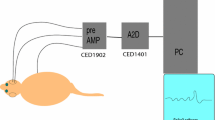Summary
In acute experiments on rabbits nystagmus was induced by rhythmical electrical stimulation of the ampullary receptors. Square-wave stimuli at 10–60 impulses per sec were applied by means of a bipolar electrode inserted in the ampulla of the horizontal semicircular canal. The nystagmus was recorded by my own photographic method, and the results were analyzed statistically. The ratio of the speed of the fast and slow components of the nystagmus to the stimulus frequency was determined. It was found that for the fast component there was an optimum stimulus frequency. The speed of the slow component continued to increase with increase of frequency. The results are in line with data on the analysis of nystagmus following stimulation and show that there is a direct relationship between the rapid component of the nystagmus and the vestibular apparatus.
Similar content being viewed by others
Literature Cited
M. M. Levashov and V. A. Tsukerman, Zh. ushn. nos. i gorl. bol. (1961), No. 4, p. 21.
I. V. Orlov, Fiziol. zh. SSSR (1962), No. 1, p. 24.
I. V. Orlov, The electrophysiological characteristics of the vestibulomotor reflex arcs. Author's abstract of candidates dissertation, Leningrad (1963).
S. N. Kechinashvili, Vestibular function [in Russian] Tbilisi (1958), p. 84.
K. L. Khilov, The cerebral cortex in the function of the vestibular analyzer [in Russian], Moscow, Leningrad (1952), p. 8.
R. A. Fisher, Statistical methods for research workers [in Russian], Moscow (1958), p. 101.
B. Gernandt, J. Neurophysiol (1949), vol. 12, p. 173.
Idem, Acta physiol. scand. (1950), vol. 21, p. 61.
Idem, p. 73.
J. J. Groen, O. Lowenstein, and A. J. H. Vendrik, J. Physiol. (London) (1952), vol. 117, p. 329.
W. Steinhausen, Pflüg. Arch. ges. Physiol. (1933), Bd. 232, S. 500.
A. A. van Egmond, J. J. Groen, and L.B. W. Jongkees, J. Physiol. (London) (1949), vol. 110, p. 1.
A. A. van Egmond and J. Tolk, Acta oto-laryng, (Stockh) (1954), vol. 44, p. 589.
A. A. van Egmond and J. J. Groen, Pract. oto-rhino-laryng. (Basel) (1955), vol. 17, p. 206.
Author information
Authors and Affiliations
Rights and permissions
About this article
Cite this article
Levashov, M.M. The rate of the rapid nystagmus movement during rhythmical electrical stimulation of the ampullary receptor (relation between the rapid component and the vestibular apparatus). Bull Exp Biol Med 59, 4–7 (1965). https://doi.org/10.1007/BF00782051
Received:
Issue Date:
DOI: https://doi.org/10.1007/BF00782051




